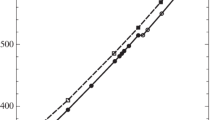Abstract
The change in the structure of solid hydrogen upon compression along the isotherm of 100 K near the transition to the conducting state has been investigated within the density-functional theory. The dependences of pressure and electrical conductivity on the hydrogen density have been calculated. The pressure range from 602 to 836 GPa has been found where the first peak of the pair correlation function arises at a distance of 0.92 Å, which corresponds to the interatomic distance in the molecular \({\text{H}}_{3}^{ + }\) ion. Notably, this distance does not change with an increase in density. A sharp increase in the electrical conductivity is also observed.



Similar content being viewed by others
REFERENCES
E. Wigner and H. B. Huntington, J. Chem. Phys. 3, 764 (1935).
V. A. Ginzburg, On Physics and Astrophysics. Papers and Reports, 2nd ed. (Nauka, Moscow, 1992) [in Russian].
R. Dias and I. F. Silvera, Science 355, 715 (2017).
N. W. Ashcroft, Phys. Rev. Lett. 21, 1748 (1968).
E. G. Brovman, Yu. Kagan, and A. Kholas, Zh. Eksp. Teor. Fiz. 62, 1492 (1972).
E. G. Brovman, Yu. Kagan, A. Kholas, and V. V. Pushkarev, Pis’ma Zh. Eksp. Teor. Fiz. 18, 269 (1973).
Yu. Kagan, V. V. Pushkarev, and A. Kholas, Zh. Eksp. Teor. Fiz. 73, 967 (1977).
C. J. Pickard and R. J. Needs, Nature Phys. 3, 473 (2007).
N. A. Kudryashov, A. A. Kutukov, and E. A. Mazur, JETP Lett. 104 (7), 460 (2016).
N. N. Degtyarenko, E. A. Mazur, and K. S. Grishakov, JETP Lett. 105 (10), 664 (2017).
G. Rillo, M. A. Morales, D. M. Ceperley, and C. Pierleoni, J. Chem. Phys. 148, 102314 (2018).
G. Kresse and J. Furthmüller, Phys. Rev. B 54 (16), 11169 (1996).
J. P. Perdew, K. Burke, and M. Ernzerhof, Phys. Rev. Lett. 77 (18), 3865 (1996).
M. Cafiero and L. Adamowicz, Chem. Phys. Lett. 387, 136 (2004).
G. E. Norman and I. M. Saitov, Dokl. Phys. 62 (6), 284 (2017).
Author information
Authors and Affiliations
Corresponding author
Additional information
Translated by A. Sin’kov
Rights and permissions
About this article
Cite this article
Norman, G.E., Saitov, I.M. The Mechanism of the Transition of Solid Hydrogen to the Conducting State at High Pressures. Dokl. Phys. 63, 272–275 (2018). https://doi.org/10.1134/S102833581807011X
Received:
Published:
Issue Date:
DOI: https://doi.org/10.1134/S102833581807011X




